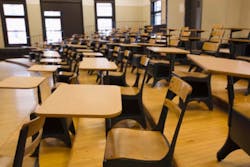Ten years ago this fall, Wall Street’s historic crash and tumble into the Great Recession derailed countless careers and caused millions to scramble for whatever jobs they could find.
One unexpected stop for me, a journalist since college, was as a custodial manager for a contractor to one of the nation’s largest public schools systems. With little training, I was suddenly responsible for managing 60-plus union custodians charged with cleaning and maintaining 16 elementary schools, most in high-crime, urban areas. (Gulp!) I didn’t last long.
But one thing that has stuck with me from that brief period is a profound respect for the majority of custodians, building engineers, teachers, students, and parents, most trying to make the best of a dangerous and under-funded situation. Indeed, the 24/7 challenge of maintaining the deteriorating physical plant at those schools prompted myriad stop-gap solutions that can be found in similarly cash-strapped school districts across the U.S. If any schools near you are teaching students in modular temporary trailers, then you know exactly the kind of triage I’m talking about.
Think about that.
As commercial and industrial buildings today become infinitely more complex and interconnected via monitors, controls, and sensors, most of the K-12 facilities where our children are being trained for the future are simply substandard.
According to a 2016 study, State of Our Schools: America’s K–12 Facilities, schools currently spend about $50 billion annually on maintenance and operations, and another $49 billion on new school construction and capital development. But what they should be spending to keep up with facilities is $145 billion annually. So we are underspending on school facilities by about $46 billion per year, according to the study, a joint publication of the 21st Century School Fund, Inc., U.S. Green Building Council, Inc., and the National Council on School Facilities.
Specifically, one can even draw a straight line from HVACR maintenance levels to student performance. “Breathing fresh air is not only critical for keeping students healthy but also for keeping them alert,” the research noted. “Several studies have linked recirculating air and low ventilation rates in classrooms with lower average daily attendance and slower speed in completing tasks.”
In 1995, the Government Accounting Office (GAO) published a report that found that half of all U.S. schools had problems linked to indoor air quality (IAQ), and that as many as 15,000 facilities then were circulating air deemed “unfit to breathe”. Despite the vast sums invested since, repairs have not kept pace.
So, what can we do? Well, get involved. There are elections coming up this fall and school construction referenda is certainly on many ballots nationwide. So, let your friends, neighbors, and elected officials know where you stand. Granted, engineers are expected to support more engineering projects. But there is so much political short-sightedness in play this year that perhaps you can remind your fellow Americans that we ALL benefit when our schools have the right climate for learning.
About the Author
Rob McManamy
Editor in Chief
An industry reporter and editor since 1987, McManamy joined HPAC Engineering in September 2017, after three years with BuiltWorlds.com, a Chicago-based media startup focused on tech innovation in the built environment. He has been covering design and construction issues for more than 30 years, having started at Engineering News-Record (ENR) in New York, before becoming its Midwest Bureau Chief in 1990. In 1998, McManamy was named Editor-in-Chief of Design-Build magazine, where he served for four years. He subsequently worked as an editor and freelance writer for Building Design + Construction and Public Works magazines.
A native of Bronx, NY, he is a graduate of both the University of Virginia, and The John Marshall Law School in Chicago.
Contact him at [email protected].


